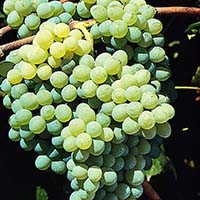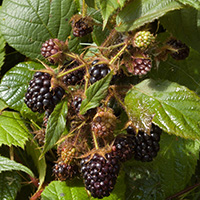While there's a rustic glamour in a lush, productive backyard vegetable patch. The days of relegating edibles to the kitchen garden are over. Bringing berries into the landscape combines beauty and practicality. From the summertime trifecta of strawberry, raspberry, blueberry, to more unusual. For instance, gooseberries, elderberries and grapes (yes, grapes are technically berries). Plant in thick stands for full-on hedges and tuck them into mixed perennial beds and borders. Fill containers and twine them against fences or train to clamber up walls. All that beauty is yours for the picking!
Selecting the right cultivar for the usage is key. Some shrubs make great foundation plantings, while others will sprawl and spread and are better as informal hedges. Decide what you're going for. Then as long as you have plenty of sun and can provide regular water, you can have an edible space. Here are five ways to bring on the berries.

As a privacy-making, bird-loving, edible hedgerow
If you want a hedge to create a garden room, or screen the neighbors, consider taller berry-producing shrubs. Or, raspberry or blackberry varieties with naturally standing or erect, long canes. Consider their ultimate height. They can be trimmed, but look best, and produce the most fruit, if allowed to grow to their natural height. Most are deciduous; if privacy is critical, combine with evergreen shrubs. These are delicious:
As an “I’m so elegant” espalier on a fence, wall, or trellis
Some varieties of raspberries and boysenberries put out pliable, long (often 5' or longer) canes. They can be trained on a trellis against a wall or tied onto an existing fence. With hard pruning, grape vines can also be similarly trained. To create a linear pattern, select the strongest canes or vines and prune away the rest. While you’ll be sacrificing fruit, you will have a French-garden inspired look that’s both unique and delicious. These will work like a charm:
As an unexpected groundcover
Low growing edibles such as strawberries and some lingonberries and blueberries can fill in spaces. Especially under open-canopy trees and sunny shrubs, grow along walkways and front flower bed. Unlike woody herbs (also excellent edible groundcovers) most edible fruiting plants cannot withstand foot traffic. Plant them where they’ll be protected. Here are few to consider:
As a portable feast outside the kitchen door
Grabbing a handful of berries to toss into your morning cereal should be a right, not a privilege! The newest hybrids are compact, low-to-medium height shrubs that produce a sizeable crop of full-sized berries. Many produce more than one crop in a season. They're ideal for containers which can be placed in sunny spots near the house. In container 24" or larger, try mixing with perennials or compact roses. Try these:
As a wild, tumbling, romantic bramble patch
You want a bramble patch if you have the following. If you have a fairly large space (and aren't overly concerned with things being neat and tidy). And, if you want the maximum amount of fruit. Brambles are generally raspberry and blackberry plants. While they can be persistent, even bullies in the yard, they can be tamed with proper pruning. These deliver:




















Please login to comment.
Don't have an account?
Sign Up for free